Is Kyron's new Gaia Evolution the most incredible hi-fi system in Australia?
A dozen 12-inch drivers and a large pair of subwoofers are just the start of Kyron's Gaia Evolution
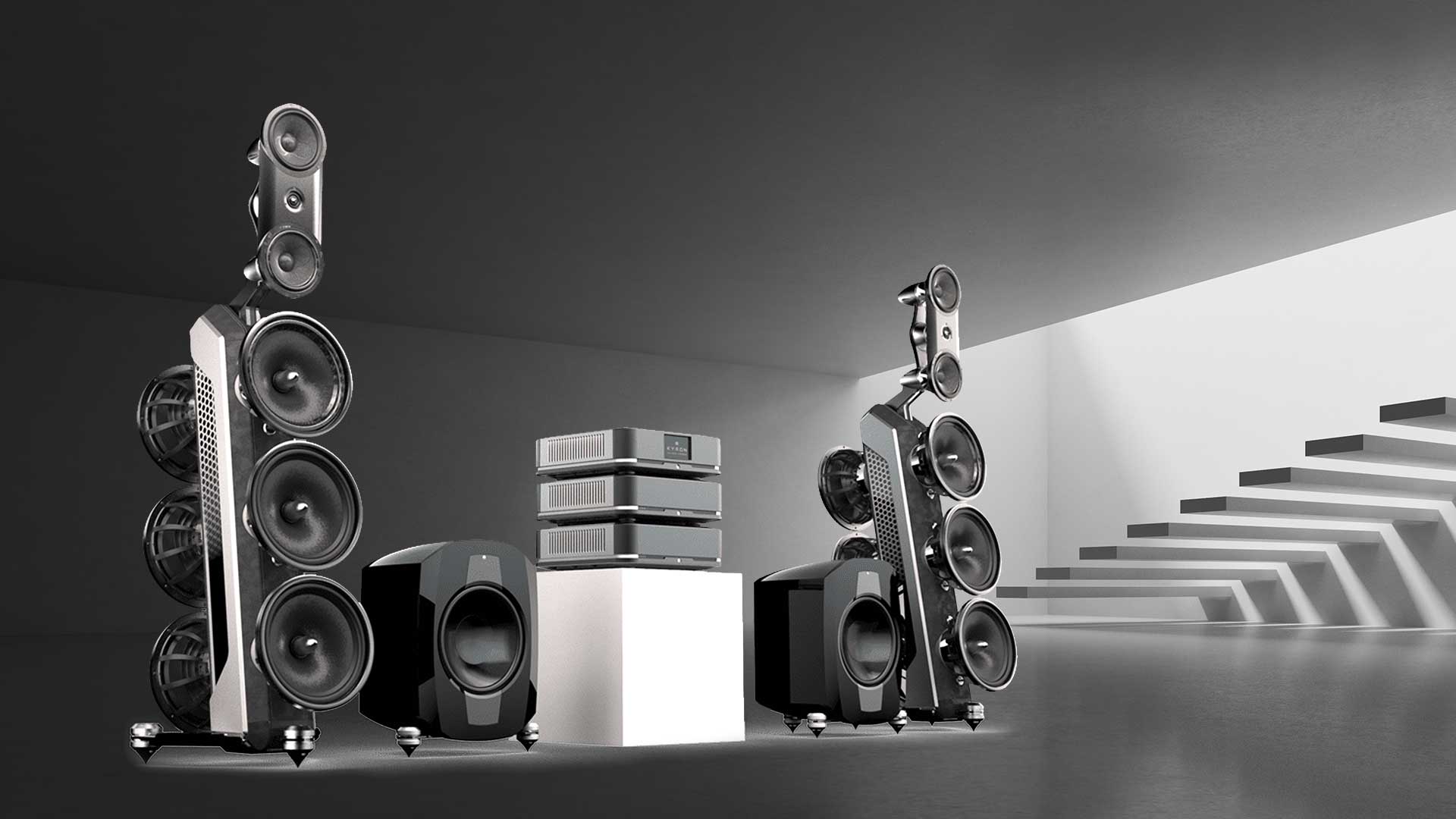
Back in 2011, the Australian Audio & AV Show was a great excitement in itself. For the previous decade there had been no proper hotel-based hi-fi shows in Australia at all, so the organisers had no template to work from, making the choice of a high-class Melbourne CBD hotel a bold start to the enterprise.
It was a success, with some world-class demos and some world-beating loudspeakers: Cabasse had its giant eyeball-like La Sphere, Bowers & Wilkins its 800 Series, and some notably impressive presentations from local brands including SGR Audio, W.A.R. and VAF Research.
But there was little debate about which room should win Best Sound in Show. The accolade went to an Australian newcomer with an extraordinary high-end 20-driver loudspeaker system which didn’t merely amaze everyone who saw it, it left all who heard it positively breathless at the extraordinary realism and effortless power it delivered; it was like nothing else at the Show, and like nothing else in the hi-fi market. The company was Kyron, and that all-conquering speaker system was Gaia.
Now, 11 years on, and with several other systems under its belt, Kyron has revisited that Gaia design to create a new system, which it calls Gaia Evolution. And the price: AU$289,000.
From scratch to Gaia
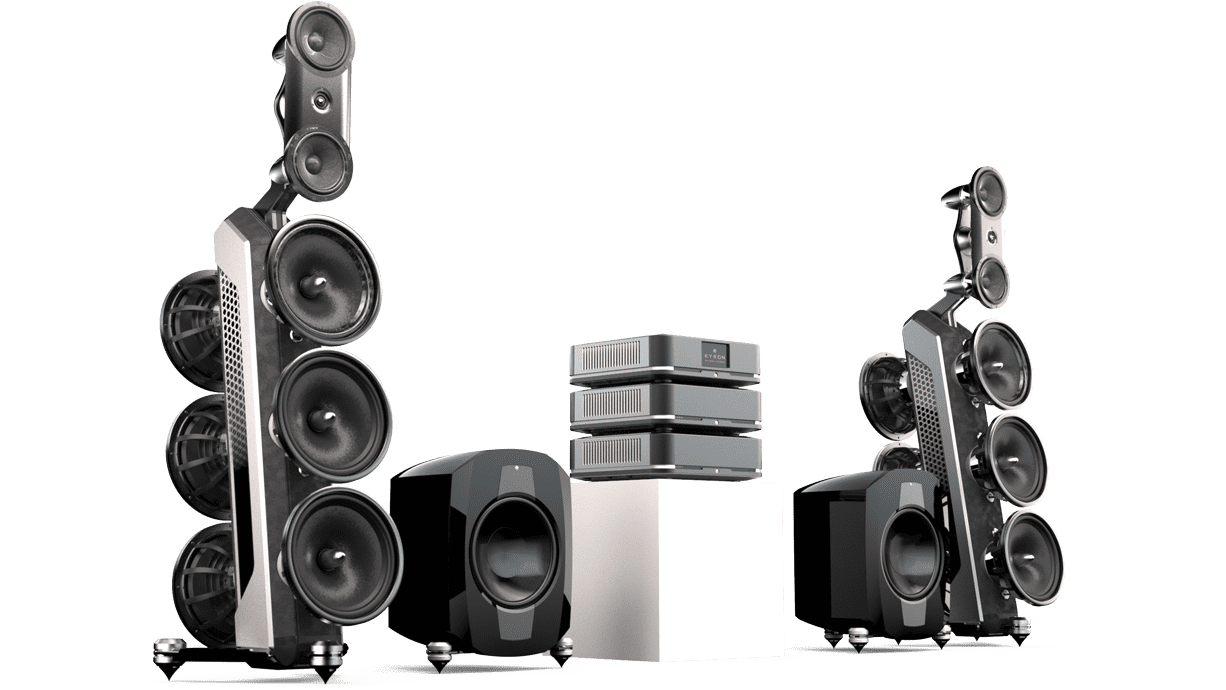
PRICE: AU$289,000
CONTROL UNIT
Inputs: 1 × unbalanced RCA analogue, 1 × XLR balanced analogue, 1 × USB-B, 1 × optical digital, 1 x coaxial digital, 1 × BNC digital, 1 × AES/EBU
Outputs: CA-COM to amplifiers, XLR balanced to subwoofers
Amplifiers: 4 × NCore 600W peak
LOUDSPEAKERS
Tweeters: 2 × 26mm ring-dome
Midrange: 2 × 180mm
Woofers: 6 × 12-inch long-throw dipole
SUBWOOFERS (each)
Driver: 1× 12-inch ultra-long-throw aluminium cone
Power: 2500W
You don’t need our descriptive powers to realise how unusual is the Gaia Evolution system in design terms: just look at the pictures. This is a non-box dipole speaker design; there is no ‘cabinet’ to speak of, and very little that could even be described as a baffle, other than for the midrange and tweeter assembly.
The decision to go so skeletal was made during initial development, after a dissatisfaction with an early prototype Gaia, which Kyron’s team of Leon Suter and Lee Gray had initially imagined as a hybrid design — a sealed bass enclosure handing over to dipole upper-bass and midrange, then “a huge 20-odd kilogram ribbon tweeter element being held aloft by a giant aluminium claw”.
But they turned away entirely from any boxed approach after hearing a disappointing resonance in the air cavity behind the bass woofers, as well as the effect of air-spring compression within the sealed enclosure.
Get the What Hi-Fi? Newsletter
The latest hi-fi, home cinema and tech news, reviews, buying advice and deals, direct to your inbox.
There are no ‘springs’ in Gaia’s final boxless and minimalist baffle design of Gaia. A sealed box has one spring to overcome: the air in the box. A ported speaker has two — the box and the air in the port. These springs are set in motion by the movement of the woofer, and continue to affect the woofer in return until they come to rest, even if the amplifier signal has stopped.
The Gaias’ box-less dipole approach evades the smearing or compression of an air-spring, as well as the resonance of a box cabinet. Suter and Gray are both musicians, and they loved how the result immediately sounded more realistic: the articulation and punch of low-end sounds without the typical bloom and bloat you get from box designs.
“It was a revelation to me,” says Gray. “Finally we were able to achieve the realistic drum and bass sounds that I know so intimately as a percussionist.”
Suter was similarly convinced by the speed and tonal accuracy of the bass frequencies.
“We had done plenty of sealed and ported speakers, going to great lengths to make the bass sound as fast as possible,” he remembers. “But dipole easily eclipsed our best efforts. The end result was astonishingly fast sub frequencies, perfectly represented. We realised that we wanted to create a speaker that was incapable of making any ‘box’ sound.”
One challenge with dipole designs is how to shift enough air forward, especially for bass frequencies. Kyron knew a planar solution wouldn’t deliver the volume of air they were aiming for, so the Gaia uses moving-magnet cone speakers — big ones, and plenty of them, angled in relation to each other. The idea is to keep each driver at a similar distance to the ears of the listener, and on axis, so that from the listening position each of the rear three woofers is situated directly behind its corresponding front woofer.
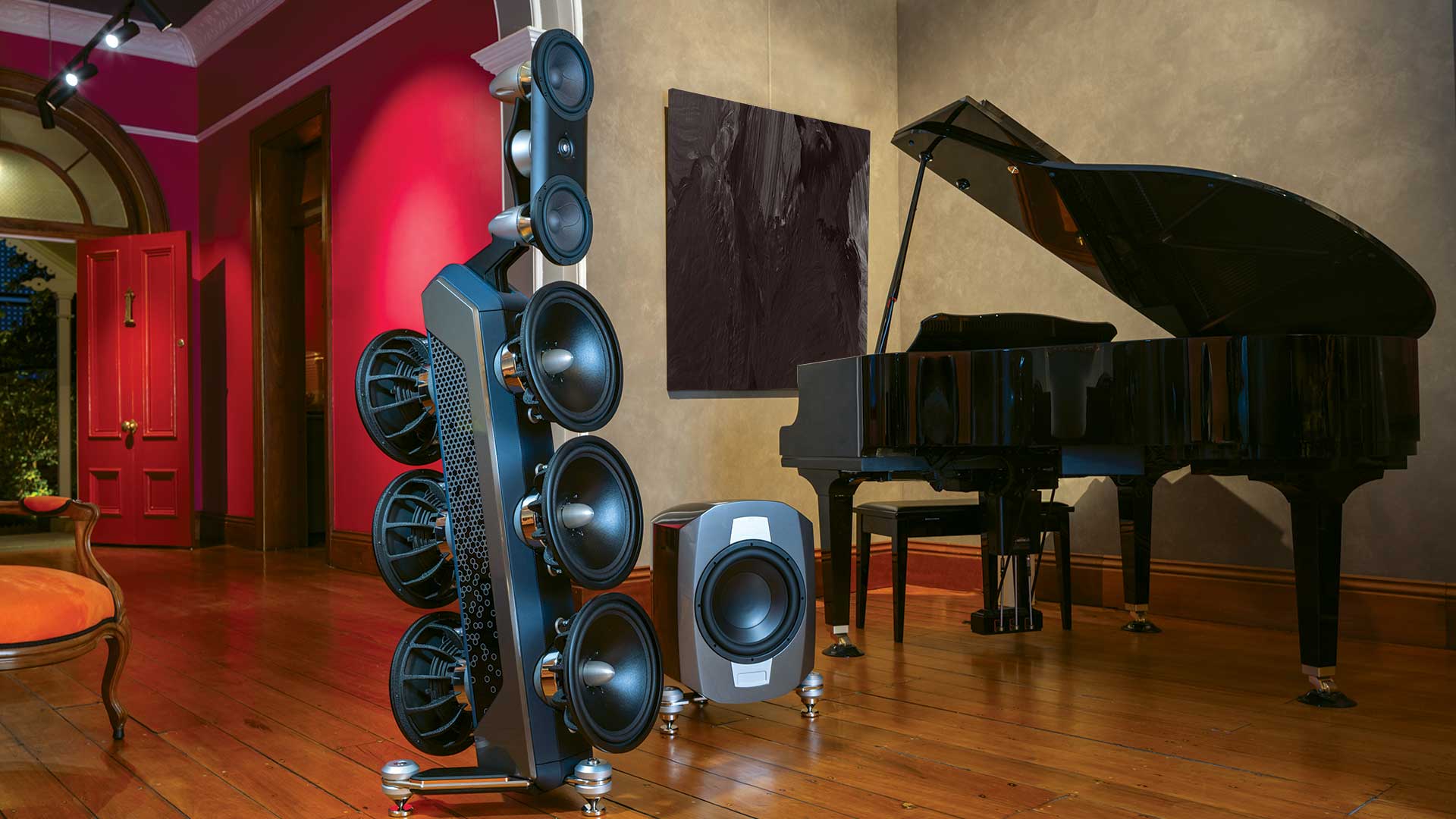
Gaia Evolution
The desire to improve on the limitations of boxless dipole bass turns out to be one of the reasons the company is now revisiting the design of the Gaia, despite the accolades bestowed upon the original a decade ago.
“The 20Hz region was the one area where we thought it could do with some help to obtain the bombastic sound pressure levels required by some listeners,” the Kyron team notes. “While Gaia does an incredible job of creating bass frequencies without the use of a box, there is only so much that can be done. To deliver 20Hz at 90dBSPL without an enclosure, physics dictates that your loudspeaker system must move approximately 110 litres of air per second. For 100dB, that escalates to an incredible 340 litres of air per second. And to put this into perspective, a pair of the best 18-inch professional touring audio subwoofer drivers will only move about 70 litres. But if you put a speaker in a box, do you know how much air you need to move to produce 100dBSPL at 20Hz? Less than 40 litres.”
So despite the six long-throw woofer drivers on the boxless Gaia being capable of moving more air than many concert public address systems, Kyron has added a pair of separate sealed subwoofers.
“It would take more than 20 no-box drivers to create the same level of sound as our one subwoofer driver,” it notes. Each channel is served a 12-inch ultra-long-throw aluminium cone and ultra-low-distortion 2500W amplifier, in an advanced sealed cabinet design. They have stainless steel leg assemblies and spikes, and internally the amplifier-driver cabling uses “military-spec” silver-plated copper wire, while the audio signal is delivered with the same low-noise low-capacitance cable used within the Gaia Control Unit and Amplifiers.
That new Control Unit assists in overcoming the challenge was to make the Gaia version of Kyron’s Mercury subwoofer integrate seamlessly with the main speakers, a task which the company says it has achieved by having the subwoofers operate only at the very lowest frequencies.
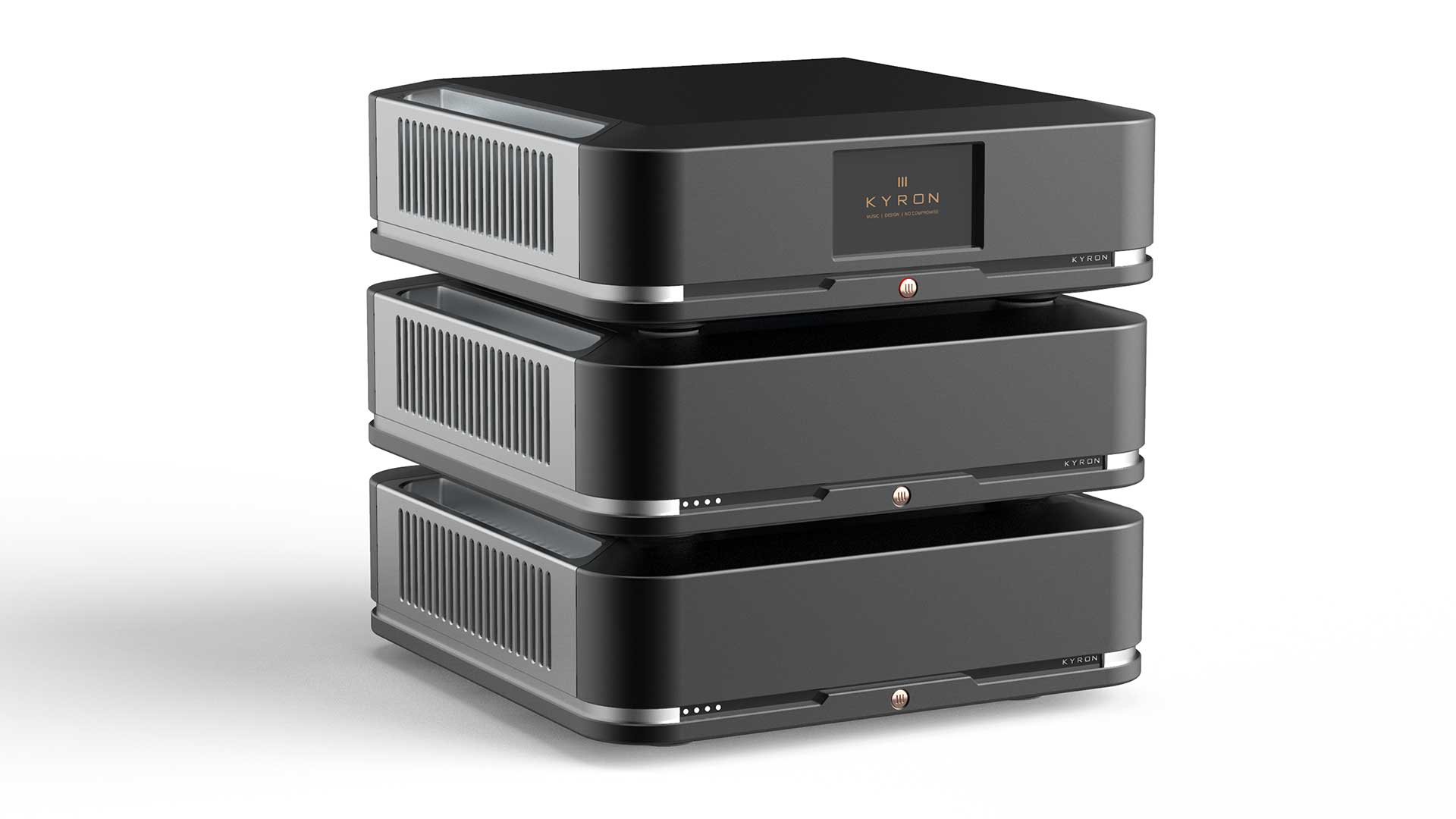
Enhanced control
While the subwoofers are the obvious physical addition to the system, the entire design has been revisited. Although it’s only 11 years since the original Gaia launch, it’s worth remembering that its development before that launch took a full eight years — so there are almost two decades of developments for the Kyron team to draw upon. That’s particularly relevant when it comes to advances in electronics and the ability to do more with the DSP in the Control Unit, which houses much of the technology responsible for the performance. As a switching preamplifier this has two analogue inputs, one unbalanced and one balanced, plus five digital inputs, including asynchronous USB Audio accepting high resolution audio up to 192kHz.
But also in the Control Unit is all the digital signal processing responsible for breaking down the signals for the amplification driving the Gaia’s separate sections, with twice the processing power of the previous Gaia to undertake linear phase crossovers, frequency response correction and group delay correction all in the digital domain of DSP, rather than using analogue crossovers. Indeed Kyron says this level of control would only be possible by doing so in the digital domain.
Five stereo DACs in the control unit convert the corrected signals before they pass to a Kyron-designed analogue stage that provides further correction required for the no-box bass efficiency. By combining this in a single circuit with the amplifier buffer stage tailored to each section, the additional simplicity has lowered overall system noise still further, says Kyron.
The Control Unit also oversees the built-in room correction system, with a microphone input to measure and correct for room distortions. Sydney-based DEQX remains responsible for both the DSP in the Gaias, and the room correction.
Cleaner power
The final amplification stages continue to use Hypex NCore modules, powerful enough to move and control the open-box drivers of the Gaia system. Part of the ‘evolution’ of the new Gaia was to isolate these power amplifiers from the Control Unit into a more ideal environment in which they can operate to their optimum abilities.
Their new separate chassis is largely sculpted from a single slab of aluminium, with separate sections for AC power, power supplies and the NCore amplifiers, and with all cabling carefully optimised to separate power tracks from shielded signal wires and tracks. The new design is said to reduce noise and distortion figures to less than 5% of those for the original design — “giving the quietest, blackest background as a canvas for the original recording to be recreated upon”, says the company. And if you’re questioning the use of Class-D amplification, please pay heed to Mr Suter.
“It is a real shame that they used a ‘D’ for this class of amplifier,” he says. “The signal enters the amplifiers as analogue, is made larger by analogue circuitry, and then exits as analogue. At no time is it converted to digital. They are really an incredible piece of analogue circuit design. While there may be some Class-D amplifiers that could be classified as digital, the NCore is not one of them.”

Driver tweaks
The many drivers of the Gaia system have also received attention in the Evolution upgrade. Indeed, where the original Gaia was a three-way design with separate bass, midrange and HF sections, Gaia Evolution is a five-way system, with those additional subwoofers and also the 12-inch bass drivers now cascaded to operate in two frequency ranges, with the top two on the front going higher, to better integrate with the midrange.
Starting at the top, then, Gaia retains two tweeters on each speaker, one forward and one rear, both one-inch ring-radiators from Scan-Speak’s Illuminator range with their patented phase plug and SD-2 Symmetrical Drive motor. The front-firing tweeter gains a new waveguide machined directly into the front baffle, shaped for a smoother response as well as an attractive embedded appearance on the minimal baffle in which it sits between the two midrange drivers.
Those 18cm drivers are also from Scan-Speak’s Illuminator range, using a special sandwiched paper cone with 42mm-diameter voice coil and an underhung neodymium magnet system (the Danish company’s SD-3 Symmetrical Drive). Kyron says it has made changes to the rear mounting of the back-firing midrange drivers and to the electrical connection and cabling, “further enhancing the midrange of our V2 Gaia to give startling midrange tonal and transient accuracy”.
Finally the 12 x 12 bass complement — twelve 12-inch bass drivers, three firing forward and three backward on each speaker; these are custom-made for Kyron since “one can not simply take a driver designed for an enclosure and expect it to perform without a box”. Enhancements for the new Gaia include changes to the suspension to further decrease distortion, the use of silver-plated solid-copper binding posts, and silicon coating of lead-out wires.
The drivers remain linked by spines, but the previous combination of steel, aluminium, plastic and visco-elastic damping has been adjusted.
“The new chassis is quite different,” Leon Suter tells us. “We moved away from steel towards stainless steel, as it is non-magnetic and has less effect on the drivers. There are still layers of aluminium separated by the visco-elastic damping layer, but bolted together now instead of welded, with extra bracing at critical points. The result is a large reduction in weight, exceptional rigidity, and no magnetic flux reduction.”
With a rigid platform free of unwanted resonances, the drivers are able to transmit the music, and nothing but the music.
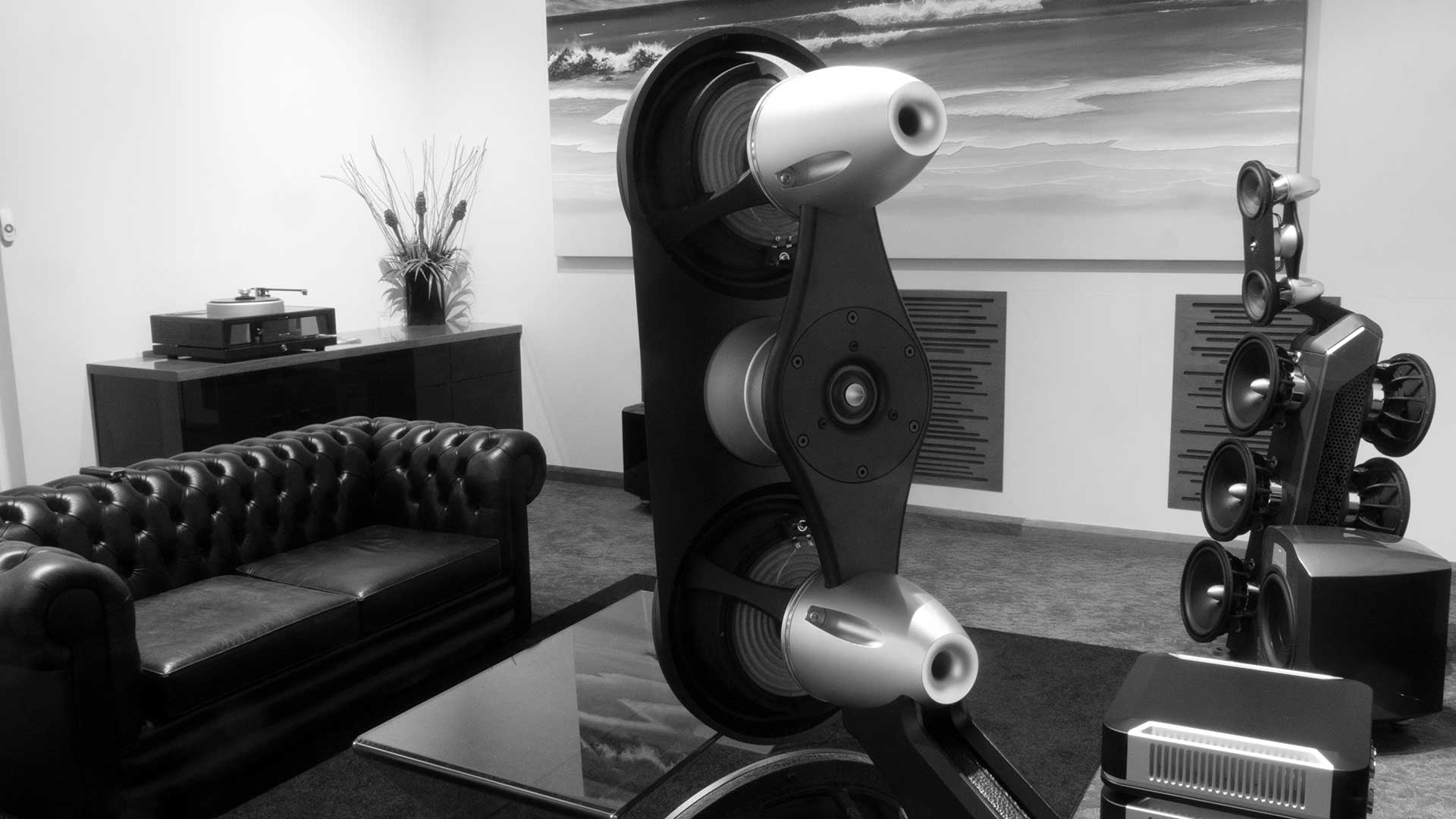
'A relaxed joy'
How would Suter describe the difference in sound over the original Gaia?
“Better!” he laughs. “More of everything that was incredible before. There’s a sense of ease and power that has elevated the Evolution to new heights. With the integration of the subwoofers, the control in the bass gives incredible resolution, speed and timbral accuracy. The midrange clarity is improved by the higher crossover thanks to the new five-way design. The high-end has been elevated to give the clarity we are known for but with a smoothness, a relaxed joy, which has come from the reduction in electronics stages, the circuit and cable design, and our custom-designed waveguide.”
The beauty of the Gaia Evolution system is physical as well as aural. The stainless-steel legs are polished for more than 100 hours to achieve the finish. And there’s the opportunity to make the Gaias even more your own, by ordering a unique colour or finish.
“Personalisation is a big part of the customer journey,” says Suter. “So if you look at the pictures showing Gaia in a home, the leather in that pair was sourced from Italy specifically to match our client’s furniture. The paint was from a concourse-winning show car. And we’ve worked with jewellers to create custom touches out of pure silver or gold, and can do other precious metals too. We have artisans that can produce parts in carbon-fibre, or the leather can be replaced with Alcantara for a more race-car look and feel. The level of bespoke finish allows for a unique and personal finish to every system.”
The sound will be unique, too, with Kyron installing the Gaia system in each client’s home, measuring subwoofer response and undertaking room correction. With no room effect, no boxes, there’s just music — and that relaxed joy.

Jez is the Editor of Sound+Image magazine, having inhabited that role since 2006, more or less a lustrum after departing his UK homeland to adopt an additional nationality under the more favourable climes and skies of Australia. Prior to his desertion he was Editor of the UK's Stuff magazine, and before that Editor of What Hi-Fi? magazine, and before that of the erstwhile Audiophile magazine and of Electronics Today International. He makes music as well as enjoying it, is alarmingly wedded to the notion that Led Zeppelin remains the highest point of rock'n'roll yet attained, though remains willing to assess modern pretenders. He lives in a modest shack on Sydney's Northern Beaches with his Canadian wife Deanna, a rescue greyhound called Jewels, and an assortment of changing wildlife under care. If you're seeking his articles by clicking this profile, you'll see far more of them by switching to the Australian version of WHF.
